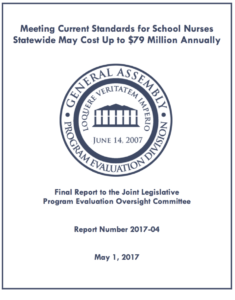May 1, 2017
Members of the Joint Legislative Program Evaluation Oversight Committee
North Carolina General Assembly Legislative Building
16 West Jones Street
Raleigh, NC 27601
Honorable Members:
At its September 12, 2016 meeting, the Joint Legislative Program Evaluation Oversight Committee directed the Program Evaluation Division to study the provision of nursing services in public schools.
I am pleased to report that the Department of Public Instruction and Department of Health and Human Services cooperated with us fully and were at all times courteous to our evaluators during the evaluation.
Sincerely,
John W. Turcotte Director
May 2017
PROGRAM EVALUATION DIVISION NORTH CAROLINA GENERAL ASSEMBLY
Report No. 2017-04
Meeting Current Standards for School Nurses Statewide May Cost Up to $79 Million Annually
Summary
The Joint Legislative Program Evaluation Oversight Committee directed the Program Evaluation Division to analyze the need for school nurses and determine how these nurses are funded. Need is growing due to increased attendance by exceptional children and students with chronic conditions as well as laws and policies expanding the health care responsibilities of schools. Only 46 of 115 Local Education Agencies (LEAs) currently meet the school nurse-to-student ratio of 1:750 recommended by the State Board of Education in 2004. Achieving either the 1:750 ratio or providing one nurse in every school (the current recommended standard of the National Association of School Nurses) would cost between $45 million and $79 million annually.
The State created two initiatives to address the demand for school nurses—the Child and Family Support Teams (CFST) and the School Nurse Funding Initiative (SNFI). The two programs have differing criteria and the distribution of nurses lacks periodic review. Although these programs increased the number of nurses, state funding has not increased to meet demand and there is a substantial funding gap between CFST and SNFI. In addition, the CFST program was established to provide services at specific schools with at-risk students. However, following the removal of state oversight of the program, CFST nurses now function as regular school nurses and not exclusively as part of an interagency team.
Approximately 60% of all medical procedures conducted in schools are performed by school employees who are not nurses. As a result, students are vulnerable to errors and gaps in emergency medical care, and funding intended for education is being used to subsidize health care. Furthermore, unlike other school-based services such as speech therapy, few LEAs file for Medicaid reimbursement for nursing services because, under the current Medicaid State Plan, a Registered Nurse must provide the care as ordered by a physician as part of an Individual Education Plan for the student.
The General Assembly should direct the State Board of Education to formulate a new goal for school nurse staffing levels and a strategic plan to meet those levels. The General Assembly should direct the Department of Health and Human Services (DHHS) and the Department of Public Instruction to combine CFST and SNFI into a single program and implement acuity models at state and local levels. The General Assembly should also direct DHHS to request a Medicaid State Plan amendment to authorize Medicaid reimbursement for school-based nursing services documented in an Individual Health Plan or a 504 Plan and to review school-based nursing service rates to ensure they are set appropriately.
